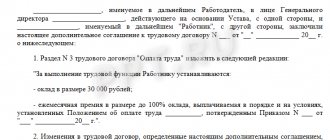Home / Labor Law / Payment and benefits / Wages
Back
Published: March 16, 2016
Reading time: 8 min
0
5457
The wage fund includes all types of payments made to employees of the enterprise for a certain period of time from the enterprise budget. These are wages, bonuses, allowances, compensation.
Correct fund calculation is necessary at all stages - both in the process of planning investments and profits, and subsequently for basic financial forecasts and reporting. For this, there is a special formula into which the relevant data is substituted; the efficiency of the enterprise depends on the correct calculation.
- What does the fund consist of?
- Fund structure
- What data will be required for the calculation?
- Calculation procedure Annual
- Monthly
- Day
- Essential workers
What does the fund consist of?
The following employee payments are taken into account:
- salary for time actually worked, or unworked, as provided for by law;
- incentive payments - bonuses, additional payments for performance indicators;
- compensation – payments for working conditions;
- dividends on shares;
- regular accruals - financial assistance, bonuses and incentives, other payments provided for by law or established locally at the enterprise - payment for travel, food, fuel.
Amounts financed by the state or illegal armed groups are not taken into account:
- children's, assistance in caring for children and disabled children;
- payment for temporary disability;
- cost of uniforms and PPE;
- expenses for training, advanced training, professional retraining;
- compensation due to work injuries.
How to analyze existing deviations
The first task when analyzing payroll is to identify deviations. This is needed for the following reasons:
- Detection of reasons for discrepancies with the drawn up plan.
- Elimination of all factors that influence the occurrence of deviations.
To establish deviations, it is necessary to correlate the current payroll indicators with the previous ones. For calculations, this formula is used: AO = PFOT – PFOT.
The formula uses these values:
- AO – absolute level of deviations.
- PFOT – actual level of payroll.
- PFOT – planned value of payroll.
The formula is universal, that is, it is suitable for both the entire legal entity and its divisions. To compare salaries and execution of plans, you will need this formula: OO = PFOT – PFOT * K.
The formula uses these values:
- K – plan fulfillment coefficient.
- FFOT is the actual indicator of the fund.
- PFOT – planned value.
Such calculations will allow us to correlate the deviation with labor productivity in the subject.
Fund structure
The structure of the fund is divided into categories - basic salary, additional, other payments (including one-time payments).
The basic salary is determined by the amount of time worked according to the tariff or salary. These are all regular and periodic payments in the form of bonuses, allowances (for length of service, length of service), local additional payments (regional coefficients), incentive payments for quality of work, compensation for working conditions (dangerous, harmful), night shifts, additional payments for overtime hours and work on holidays and weekends.
Additional wages consist of payments for unworked time: idle time, vacations, preferential hours, time spent performing public works.
Other payments include travel allowances, clothing, and social payments.
One-time incentives include rewards for length of service, bonuses (at the end of the year, among other things), compensation for unfulfilled vacations, financial assistance
Analysis of salary expenditures from an efficiency point of view
There is a formula for determining the effectiveness of spending on motivating specialists. In particular, the employer needs to correlate the growth rate of the payroll with the growth of labor productivity. To establish the desired value, a number of calculations are required. Let's look at all of them.
First, the rate of salary increase is determined: IZ = SZF/SZP.
The formula uses these values:
- SZF – actual average salary.
- SWP is the planned value of the average salary.
We calculate the productivity growth index: IP = VPF / VPP.
The formula uses these values:
- VPF is the actual output of the organization.
- Runway – planned production indicator.
The advance coefficient is calculated: K = IP/IZ.
The formula includes these indicators:
- IP – productivity growth index.
- IZ – rate of salary increase.
That is, the last formula uses the values found as a result of previous calculations. As a result, we get the coefficient. It also needs to be analyzed. A position in which the coefficient exceeds one can be considered optimal. This indicates that labor productivity is growing faster than wages. If the resulting value is less than one, this indicates an overexpenditure of the payment fund. It stands for these negative points:
- Irrational increase in production costs.
- Reduction in net profit.
In a situation with a low ratio, it is necessary to look for ways to increase efficiency, reduce employee salaries, and reduce personnel.
What data will be required for the calculation?
Based on the following data, it is possible to make a calculation:
- number of employees;
- number of hours worked;
- nature (conditions) of work.
Data on the quality of work of employees, their successes and achievements (contained in the reporting statements).
Classic general formula:
Pay fund = wages (salary part) + additional payments (bonuses, bonuses, allowances, compensations)
A one-time payment from the funded part of the pension - read about how to receive it! You can find out all the information you need about applying for a pension here.
Lately, the government has been increasingly talking about raising the retirement age. How it will happen, read in this article.
Usage Analysis
Usage analysis is necessary for various fields. Among them:
- increasing efficiency and optimizing processes and costs;
- budget planning;
- elimination of errors that lead to costs going beyond limits.
The analysis itself is used for more effective economic management of the organization, since the planned budget of the entire company can be distributed more correctly. The scope of analysis is carried out by accounting employees, as well as special financial analysts, if the organization is particularly large and has a large staff.
An additional factor in using the analysis is the full implementation of all labor standards that relate to the remuneration of workers, since otherwise the enterprise may receive various sanctions for failure to comply with legal standards.
Payment procedure
Depending on the period for which the calculation needs to be made, there are annual, monthly, daily and hourly types of fund. The data is taken from statements, work report cards, and staffing schedules. For each such period there is its own formula.
Annual
Annual figure = average salary * number of employees * 12 (months)
In this case, indicators are taken for each group of workers separately (management, ordinary employees), multiplied by the number of workers in these groups, then the results are added up.
To determine a resource, most often they take a calculation period equal to the calendar year (the last one), and based on its data, calculations are made.
All amounts that were paid to employees of the enterprise for twelve months,
fold up. In this case, only regular payments are taken into account, one-time (social) payments are not taken into account.
It is necessary to sum up the number of hours worked by all employees for. Data is taken from time sheets.
The average number of employees in the timesheet is determined. The number of personnel for each working day is added up and the result is divided by 30 (average number of days). The results obtained for each month of the year are added up, then the sum is divided by 12 (months).
Monthly
To calculate the monthly fund, it is necessary to add up all the amounts that were accrued to employees during a given period, divide the amount by 12. Also divide the number of all days worked during the year by 12. Divide the average monthly salary for all employees by 30. The resulting result is divided by the number employees working in a given month.
Day
The daily payroll is calculated in the same way as the monthly payroll, taking into account that you need to divide by 30.
The total annual payroll includes salary funds:
- essential workers;
- auxiliary;
- management;
- engineers;
- Employees;
- MOP.
Formulas for calculating the wage fund
To assess the situation with the wage fund, the formula for calculating the indicator is presented in 2 options. The choice of method for calculating the payroll depends on the characteristics of the enterprise and the payment systems used (transaction, tariffs, salaries). The total payroll is calculated based on the number of employed citizens, average pay, possible costs in social areas, and the period under review.
The first payroll formula, how to calculate the indicator, is presented below:
Example
Earnings (average monthly) x Number of employees (average list) x number of months (if the year is 12). The second option, how to calculate the wage fund for the year, takes into account regional coefficients (RC):
(Salary per year + allowances) * RK.
If it is necessary to calculate the wage fund using the formulas above for a month or another period, use the values corresponding to the selected period.
Payroll for a month or other period
The above formulas are suitable for calculations for any required period, for example, the monthly wage fund is similar indicators of the average salary multiplied by the number of personnel for 1 month.
How is the wage payable?
Payroll calculations are carried out taking into account the methodology adopted by the enterprise and the provisions of regulations.
- Conditions of monetary compensation for unused vacation
The formula for calculating wages depends on the existing remuneration structure:
- salary deductions;
- paid downtime;
- compensation for vacation, forced absence;
- awards, bonuses, incentives;
- compensatory deductions for payment of utilities, accommodation, food, if this is established by the company’s rules.
The methods for calculating the wage fund correspond to the procedure used in determining the amount of wages, with the determination of the total values of each component of the wage fund formula.
Calculation of payroll for different categories of employees
Essential workers
We calculate the annual salary fund for this category using the formula:
VTP * hourly tariff rate + bonus
Example:
Turners, foundry workers and assemblers work at the plant, which has a piecework-bonus wage system for key workers with a 50% bonus. The tariff rate for each profession is 75, 65 and 75 rubles per hour, respectively.
It is necessary to calculate the payroll for this category:
1. First, we calculate separately for each profession:
| Profession | Payroll, rubles per year |
| turner | 25432,56 * 75 * 1,5 = 2,861,163 |
| caster | 21927,48 * 65 * 1,5 = 2,137,929 |
| pickers | 28987,88 * 75 * 1,5 = 3,261,136 |
2. We add up all the resulting amounts and get the payroll for this group of workers.
Auxiliary workers
The salary for this category is time-based bonus. Formula for calculating payroll:
Number of auxiliary workers * T pl. r * hourly tariff rate + bonus part
The NPV is the same for all categories and is equal to the arithmetic mean.
For example:
There are six auxiliary workers at the plant.
We calculate according to the formula.
1. First, determine the average hourly rate
(75 + 65 + 75) : 3 (number of bets) = 71 rubles per hour.
2. Then we substitute the values into the formula and get the result:
6 * 1900 * 71 * 1,5 = 1,214,100
How to calculate payroll
The calculation depends on the availability of the necessary data, as well as the specified calculation period. For example, the annual option is needed for an annual report, and the daily option is most often used for daily payment or analysis.
Universal scheme
The universal method uses the totality of all amounts. A special formula is used for calculation:
Annual payroll = Salary-m x Chsr-sp. x 12, where:
- ZPs-m - monthly salary indicator, that is, the total annual value divided by 12;
- Chsr-sp. — average number of personnel.
Average number refers to the number of employees each day during the month. The average payment is calculated according to the statement, and the average composition of employees according to the accounting of staff units every month. It turns out that staff units are being added and then divided by 12.
The universal scheme is more often used when it is necessary to calculate the annual preliminary consumption.
When paid hourly
When using hourly wages, use the formula FOThour = ∑st. x RF .
RF is the number of hours worked and ∑st. the total rate for all hourly employees.
With piecework payment
The piecework system has its own special type of formula.
It looks like this: PAYROLL of piecework wages. = (Vpl. x Tsed.) + K + N + Pr. + Vsots ., where:
- Vpl. — planned volume of goods;
- Tsed. - unit price of the product that was produced;
- K - compensation of any nature;
- N—surcharge;
- Etc. — bonuses;
- Vsots.—necessary social payments.
If necessary, additional amounts may be added as provided by law or the organization’s charter.
How to calculate the annual payroll?
To calculate the annual amount, you need to know a number of quantities. Among them:
- the amount of salaries according to the statement that were paid;
- time sheet with the indicated number of hours;
- additional costs indicating their amounts in local regulatory documentation;
- number of employees by state;
- a form of security used by a company.
If we know the average monthly amount and the number of employees, we obtain SMZ × PE × 12 . When these amounts are multiplied, the total annual fund is obtained.
If there are several groups of personnel with different forms of payment or amounts of payments, they are combined into their own categories, which are calculated in a similar way. After this procedure, the total amount is added up from the obtained values.
How to find monthly payroll?
The monthly size is similar to the annual size, only without using the number of months.
It turns out that data is needed on the number of employees, as well as the amount of all payments. The product of the indicated amounts will be the monthly amount. Read also: Responsibility for non-payment of taxes in 2021
If some workers work on a piece-rate basis, and some on a standard basis, then the two values are calculated independently, after which they are added together.
In what situations is it required?
When concluding an employment contract, the employee and the employer negotiate wages corresponding to the position held. Its size, as well as other guaranteed payments to the employee, are indicated in the contract, along with this, the types of deductions are also indicated. There are situations in production when wages are paid not for actual time worked, but based on the average monthly wage (AMS).
SWP is the ratio of the actual accrued salary for a period of time to the actual time worked for this period.
Often you may be required to provide a certificate of FFP. It can be provided:
- To social protection authorities;
- To the labor exchange;
- To the pension fund for calculating labor pension;
- To the bank, when applying for a loan;
- To the courts, to calculate compensation for absenteeism due to the fault of the director of the enterprise.
In these cases, an indicator such as the average monthly salary is required. This indicator is usually calculated over three or six months.
There are periods in the labor process when an employee does not fulfill his job duties for some reason, but these periods must be paid by the employer. This payment is calculated based on the average daily earnings.
These include:
- Temporary disability;
- Annual paid vacation;
- Maternity leave;
- When an employee performs outside work, by order of the manager, but at the same time his earnings are retained (public works, negotiations);
- When calculating severance pay when reducing a position in the staffing table;
- In case of dismissal, when calculating the final payment;
- When calculating travel expenses;
- When calculating vacation pay for the period of study;
- When forced downtime occurs due to the fault of the authorities;
- Salary calculation for the day of the donor;
- Payment for days to undergo a mandatory medical examination;
- During the period of military retraining.
Calculation of average annual salary
The average annual salary is calculated in the following cases:
- if an employee goes on annual leave;
- if the employee is paid compensation for unused vacation;
- when calculating maternity leave;
- if an employee quits and needs to be paid severance pay upon dismissal and in other cases.
Normative base
The calculation of SZ is regulated by the following regulations:
- Decree of the Government of the Russian Federation of December 24, 2007 No. 922 (“On the peculiarities of calculating average wages”);
- Article 139 of the Labor Code of the Russian Federation (“Calculation of average wages”).
The documents can be found on our website:
Labor Code of the Russian Federation
Decree of the Government of the Russian Federation of December 24, 2007 N 922
Why calculate the payroll value
Now you know how the wage fund is formed. However, why this indicator is calculated may not be obvious to novice entrepreneurs and managers. Calculating payroll and tracking the indicator over time is necessary for:
- Analysis of expenses for employees of different departments, structural units, assessment of their proportionality and proportionality to labor achievements.
- Planning and regulation of all company expenses, budgeting.
- Calculation of the cost structure, assessment of the ratio of payment directly for labor activity and other payments.
- Changes in the cost of goods and, as a consequence, the economic policy of the enterprise.
- Identifying the need to improve profitability indicators and reduce costs in various areas.
Payroll and full wages - is there a difference?
Together with the concept analyzed above, the consonant term “FW”, that is, “wage fund,” is very often used. Let's figure it out, is this the same thing or are these concepts different in some way? The differences between the wages and salaries are quite easy to grasp.
The wage fund includes only the costs of remunerating the employees of the enterprise, while the payroll includes almost all transfers that the employer is obliged to make or gives to the employee at his own request. The gross wage is always less than the payroll, and is also its important (main) component.
The situation where these two values are equal is quite rare. It assumes that the employer does not transfer anything to its employees other than direct payment for work performed. This is possible when, for example, all employees are registered under civil contracts.
The wage fund includes only the costs of paying employees of the enterprise.






